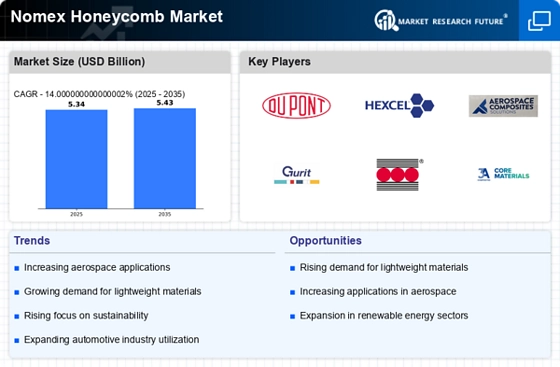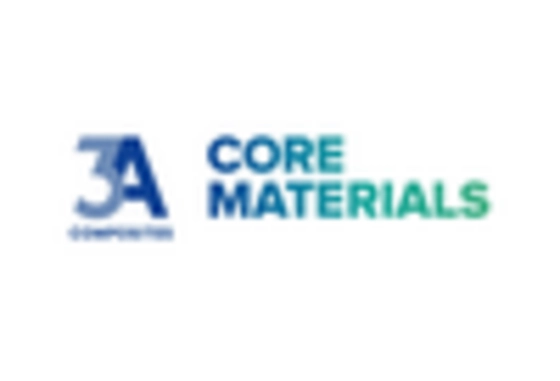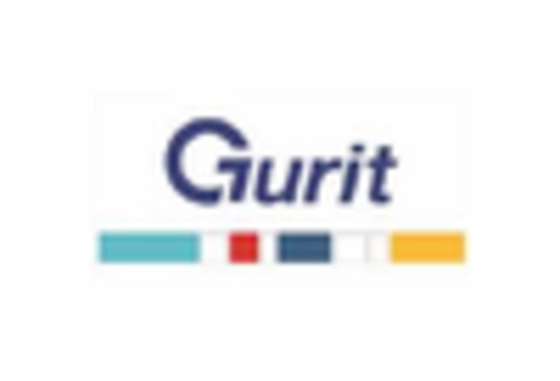Rising Demand in Aerospace Sector
The aerospace sector is experiencing a notable increase in demand for lightweight and durable materials, which positions the Nomex Honeycomb Market favorably. As aircraft manufacturers seek to enhance fuel efficiency and reduce emissions, the use of Nomex honeycomb structures becomes increasingly attractive. This material's excellent strength-to-weight ratio and thermal resistance make it ideal for various aerospace applications, including aircraft interiors and structural components. Recent data indicates that the aerospace industry is projected to grow at a compound annual growth rate of approximately 4.5% over the next five years, further driving the demand for Nomex honeycomb products. Consequently, the Nomex Honeycomb Market is likely to benefit from this upward trend, as manufacturers align their offerings with the evolving needs of the aerospace sector.
Growth in Renewable Energy Applications
The shift towards renewable energy sources is creating new opportunities for the Nomex Honeycomb Market. Wind turbine manufacturers are increasingly utilizing Nomex honeycomb materials in blade construction due to their lightweight and high-strength properties. This trend is underscored by the fact that the wind energy sector is expected to expand significantly, with projections indicating a growth rate of around 8% annually. As the demand for more efficient and durable wind turbine components rises, the Nomex Honeycomb Market is poised to capitalize on this growth. Additionally, the material's resistance to environmental factors enhances its appeal in renewable energy applications, suggesting a robust future for Nomex honeycomb products in this sector.
Expanding Applications in Defense Sector
The defense sector is witnessing an expansion in the use of advanced materials, including Nomex honeycomb, which is driving growth in the Nomex Honeycomb Market. The material's exceptional fire resistance and structural integrity make it suitable for various military applications, such as vehicle interiors, aircraft components, and protective gear. As defense budgets increase and the focus on modernization intensifies, the demand for high-performance materials is likely to rise. Recent reports indicate that defense spending is projected to grow by approximately 3% annually, creating a favorable environment for the Nomex Honeycomb Market. This trend suggests that as defense contractors seek innovative solutions, Nomex honeycomb products will play a crucial role in meeting the evolving needs of the sector.
Increased Focus on Lightweight Materials
The growing emphasis on lightweight materials across various industries is a significant driver for the Nomex Honeycomb Market. Industries such as automotive, aerospace, and construction are increasingly prioritizing weight reduction to improve energy efficiency and performance. Nomex honeycomb, known for its lightweight yet robust characteristics, is becoming a preferred choice for manufacturers aiming to meet these demands. Recent studies suggest that the lightweight materials market is expected to grow at a rate of approximately 6% annually, indicating a strong potential for Nomex honeycomb applications. This trend reflects a broader shift towards sustainable practices, where reducing material weight contributes to lower energy consumption and emissions, further solidifying the position of the Nomex Honeycomb Market.
Advancements in Manufacturing Technologies
Technological advancements in manufacturing processes are likely to enhance the production capabilities of the Nomex Honeycomb Market. Innovations such as automated production lines and advanced composite manufacturing techniques are streamlining the fabrication of Nomex honeycomb structures. These improvements not only increase efficiency but also reduce production costs, making Nomex honeycomb products more accessible to a broader range of industries. Furthermore, the integration of computer-aided design (CAD) and simulation tools allows for more precise engineering of honeycomb structures, catering to specific application requirements. As these technologies continue to evolve, the Nomex Honeycomb Market may witness a surge in demand driven by enhanced product offerings and competitive pricing.


















Leave a Comment